
CANADA-NOVA SCOTIA OFFSHORE PETROLEUM BOARD


Regional Geology Overview
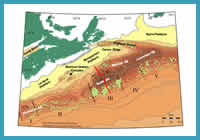
FIGURE: 1
Major tectonic elements of the Scotian Basin showing depth to basement in kilometers and bathymetric contours in grey. The black dots are industry wells, with the green dots ones that penetrated salt. The pale green areas represent earliest Jurassic age Argo formation salt structures, with the Roman numerals indicating the salt/basement regions as defined by Kidston et al. (2002) and Shimeld (2005). Trace of the regional composite seismic profile (Figure 3) is shown in red. Copyright © Geological Survey of Canada Atlantic - used with permission.
Major tectonic elements of the Scotian Basin showing depth to basement in kilometers and bathymetric contours in grey. The black dots are industry wells, with the green dots ones that penetrated salt. The pale green areas represent earliest Jurassic age Argo formation salt structures, with the Roman numerals indicating the salt/basement regions as defined by Kidston et al. (2002) and Shimeld (2005). Trace of the regional composite seismic profile (Figure 3) is shown in red. Copyright © Geological Survey of Canada Atlantic - used with permission.
Pre-Rift
The Scotian Basin is located offshore Nova Scotia where it extends for 1200 km from the Yarmouth Arch / United States border in the southwest to the Avalon Uplift on the Grand Banks of Newfoundland in the northeast (Figure 1). With an average breadth of 250 km, the total area of the basin is approximately 300,000 km2. Half of the basin lies on the present-day continental shelf in water depths less than 200 m with the other half on the continental slope in water depths from 200 to >4000 m.
The Scotian Basin formed on a passive continental margin that developed after North America rifted and separated from the African continent during the break-up of Pangea (Figure 2). It consists of a series of alternating "highs and lows", or platforms and depocentres. From the southwest to the northeast they are named the Shelburne Subbasin, La Have Platform, Sable and Abenaki Subbasins, Banquereau Platform, Orpheus Graben and Laurentian Subbasin (Figure 1). The boundaries of these platforms and basins may have been defined by regularly-spaced oceanic fracture zones that extended landward onto continental crust (Welsink et al., 1990). A northeast-trending basement hinge zone is also present along the margin, defining the landward limit of maximum tectonic extension and an abrupt seaward increase in basement depth due to thermal subsidence (Figure 3). Together, these basement elements asserted a strong control on sediment distribution in the region for more than 190 million years.
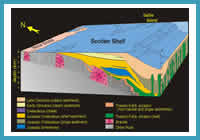
FIGURE: 2
Isometric view of the western portion of the Scotian Basin, offshore Nova Scotia. The thickness of the basal Triassic-Jurassic salt is exaggerated in this view. Copyright © Atlantic Geoscience Society - used with permission.
Isometric view of the western portion of the Scotian Basin, offshore Nova Scotia. The thickness of the basal Triassic-Jurassic salt is exaggerated in this view. Copyright © Atlantic Geoscience Society - used with permission.
Syn-Rift
Red beds and evaporates were the dominant deposits during the rift phase, whereas typical clastic progradational sequences with periods of carbonate deposition dominated the drift phase (Figure 4). These are described in more detail below.
Rifting began in the Middle Triassic Period, about 225 million years ago (Mya). At that time, the Nova Scotia region occupied a near equatorial position, situated adjacent to Morocco, with most of its older Paleozoic rocks having direct Moroccan affinities (Schenk et al., 1980). A series of narrow, interconnected rift basins were created during the rift phase and were filled with fluvial and lacustrine red bed sediments as well as volcanic rocks (Fundy-type sequences). By the latest Triassic-earliest Jurassic, tectonic motion had moved the North American and African plates slowly northward, with the Nova Scotia-Moroccan region in an arid sub-equatorial climate zone (ca. 10-20°N paleo-latitude). Renewed Late Triassic rifting of continental crust further to the north and east in the Grand Banks / Iberia region breached topographic barriers and permitted the first incursions of marine waters from the eastern Tethys paleo-ocean to flood into these interconnected syn-rift basins (Figure 5). Restricted, shallow marine conditions were established with some mixed clastic and minor carbonate sedimentation (Eurydice Formation).
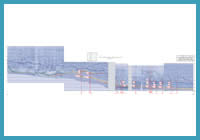
FIGURE: 3
Composite seismic section across the Sable Subbasin; the track is shown in Figure 1. This 200 kilometer long composite profile starts landward of the Jurassic carbonate bank, runs across the Sable Subbasin through several gas fields, over the shelf break and the slope across the Annapolis and Crimson deepwater wells, and out into the salt canopy complex. The profile is composed of the following data sets and used with the kind permission of the respective organizations (from west to east): GSI 2D 201 (Geophysical Service Incorporated), ExxonMobil Mega-Merge 3D (ExxonMobil), ExxonMobil North Triumph 3D (ExxonMobil), Marathon 3D (CGGVeritas) and the TGS Regional 2D (TGS-NOPEC). A comprehensive description of this line can be found in Kidston et al., 2007.
Composite seismic section across the Sable Subbasin; the track is shown in Figure 1. This 200 kilometer long composite profile starts landward of the Jurassic carbonate bank, runs across the Sable Subbasin through several gas fields, over the shelf break and the slope across the Annapolis and Crimson deepwater wells, and out into the salt canopy complex. The profile is composed of the following data sets and used with the kind permission of the respective organizations (from west to east): GSI 2D 201 (Geophysical Service Incorporated), ExxonMobil Mega-Merge 3D (ExxonMobil), ExxonMobil North Triumph 3D (ExxonMobil), Marathon 3D (CGGVeritas) and the TGS Regional 2D (TGS-NOPEC). A comprehensive description of this line can be found in Kidston et al., 2007.
Due to the hot and dry climate, the shallow seas were repeatedly evaporated, resulting in the precipitation of extensive salt and minor anhydrite deposits that were as much as two kilometers thick in the central parts of the rift system (Argo Formation).
An earliest Jurassic phase of siliciclastic deposition is observed in the west-central part of the Scotian Basin that may exist elsewhere along the margin and the Moroccan conjugate. This eastward-directed pulse of redbed sediments (Heracles unit) conformably overlies and deforms (through loading) Argo Formation evaporites in the Mohican Graben. The west-dipping listric faults inboard of the margin hinge-line on the Mohican and Naskapi grabens are interpreted as the antithetic response to extension in the Fundy Basin during the Late Triassic (Wade et al., 1996). These grabens acted as loci for clastic deposition for newly established fluvial drainage systems, with the source of the sediments from the current mainland region of Nova Scotia. While not yet encountered in wells or observed elsewhere along the margin, the age of this succession can be reasonably inferred as early Hettangian to perhaps mid- to late Sinemurian since it conformably overlies the Argo Formation and is later truncated by the younger Break-up Unconformity as described below.
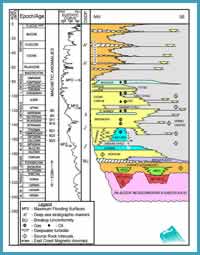
FIGURE: 4
Generalized stratigraphic column for the Scotian Basin, offshore Nova Scotia (CNSOPB). Detailed columns can be found in Wade & MacLean, (1990). Sea level curve from Haq et al. (1987).
Generalized stratigraphic column for the Scotian Basin, offshore Nova Scotia (CNSOPB). Detailed columns can be found in Wade & MacLean, (1990). Sea level curve from Haq et al. (1987).
Renewed tectonism in the central rift basin during the Early Jurassic (mid-Sinemurian) is recorded by the complex faulting and erosion of Late Triassic and Early Jurassic sediments and older rocks. This phase of the rifting process resulted in the formation of a Break-Up Unconformity (BU), which coincided with the final separation of the North America and Africa continents, the creation of true oceanic crust through volcanism, and opening of the proto-Atlantic Ocean. As a result of the BU, the heavily faulted, complex terrane of grabens and basement highs along the Scotian margin underwent a significant degree on peneplanation .
Early Post-Rift
Marine transgression above the BU, eventually covered the basin with a narrow, shallow and restricted sea within which thin sequences of carbonate and clastic sediments accumulated. Transgressive shallow water to tidally influenced dolomites and clastics were laid down in localized areas on the seaward portion of the margin under slightly restricted marine conditions (Iroquois Formation). A thick succession of coarser grained clastic sediments and shales from fluvial sources (Mohican Formation) was deposited concurrently on the basin margins. The succession was sourced from adjacent high relief terranes and eventually prograded out over the margin to fill graben lows and bury basement highs by the early Middle Jurassic (MacLean and Wade, 1990). The fine muds from this succession were transported by marine processes into deeper water where they slowly infilled basinal lows and blanketed newly formed oceanic crust.
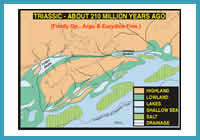
FIGURE: 5
Simplified paleogeographic reconstruction of the Scotian Basin during the Late Triassic (Rhaetian) ca. 210 mya. Salt deposition likely was initiated during this period although on a much smaller scale than illustrated here. Argo formation salts of this age have yet to be sampled in this basin but are present on the southeast Grand Banks. Copyright © Atlantic Geoscience Society - used with permission.
Simplified paleogeographic reconstruction of the Scotian Basin during the Late Triassic (Rhaetian) ca. 210 mya. Salt deposition likely was initiated during this period although on a much smaller scale than illustrated here. Argo formation salts of this age have yet to be sampled in this basin but are present on the southeast Grand Banks. Copyright © Atlantic Geoscience Society - used with permission.
The combination of sea-floor spreading, basin subsidence and global sea level rise caused the Atlantic Ocean to become broader and deeper (~1000 m) by the Middle Jurassic. A prominent carbonate bank developed in the western part of the basin at this time and persisted until the latest Jurassic-earliest Cretaceous. Growth of the carbonate bank was tempered by Upper Jurassic and Lower Cretaceous deltaic depocentres that locally overwhelmed carbonate sedimentation. The carbonate bank succession can be subdivided into a number of members. A carbonate platform and margin succession was established along the basin hinge zone (Scatarie Member of the Abenaki Formation) and prograded out into deeper waters where marls and clastic muds were deposited. Continuing margin subsidence coupled with global sea level rise resulted in transgression during which time the carbonates and other shelf sediments were blanketed by deeper marine shales (Misaine Member of the Abenaki Formation). From the late-Middle to the end of the Jurassic, carbonate reef, bank and platform environments formed and thrived along the basin hinge line on the La Have Platform (Baccaro Member of the Abenaki Formation) (Figure 6). Further north, a shallow mixed carbonate-clastic ramp succession existed on the Banquereau Platform and in deeper water a thin succession of shales and limestones were deposited (DSDP J1 Reflector).
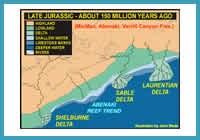
FIGURE: 6
Simplified paleogeographic reconstruction of the Scotian Basin during the Late Jurassic (~Kimmeridgian) time, ca. 150 mya. This period represents the final stage of the Abenaki carbonate margin; soon to be overwhelmed by the rapidly advancing MicMac formation siliciclastic delta systems. The margin had a ramp-like morphology between the Sable and Laurentian deltas and developed a more classic fringing reef profile elsewhere. Copyright © Atlantic Geoscience Society - used with permission.
Simplified paleogeographic reconstruction of the Scotian Basin during the Late Jurassic (~Kimmeridgian) time, ca. 150 mya. This period represents the final stage of the Abenaki carbonate margin; soon to be overwhelmed by the rapidly advancing MicMac formation siliciclastic delta systems. The margin had a ramp-like morphology between the Sable and Laurentian deltas and developed a more classic fringing reef profile elsewhere. Copyright © Atlantic Geoscience Society - used with permission.
Late Post Rift
Concurrent with carbonate deposition, regional uplift to the west resulted in an influx of clastic sediments and the establishment of the mixed energy (current and tidal) Sable Delta complex in the Laurentian Subbasin, and slightly later in the Sable Subbasin. In the southwest, a similar progradation of sediments may have occurred at an embayment in the vicinity of the U.S.-Canada border, known as the Shelburne Delta. These sediments were primarily sourced from the adjacent thick (14+ km) blanket of latest Devonian to Permian sediments centred in the Gulf of St. Lawrence region that covered the entire Atlantic Provinces region and parts of New England (Pe-Piper & Piper, 2004; Pe-Piper & MacKay, 2006). The MicMac Formation records this first phase of delta progradation into these subbasins, represented by distributary channel and delta front fluvial sands cyclically interfingering with prodelta and shelf marine shales of the Verrill Canyon Formation. The ancestral St. Lawrence River was well established by the earliest Cretaceous, delivering increasing supplies of clastic sediments into the Scotian Basin that overwhelmed and buried the carbonate reefs and banks on the La Have Platform and later the Banquereau Platform. A series of thick sand-rich deltaic, strandplain, carbonate shoals and shallow marine shelf successions (Missisauga Formation) dominated sedimentation throughout the Early Cretaceous (Figure 7). The Sable Delta prograded rapidly southwest into the Laurentian and Sable Subbasins and over the Banquereau Platform, while in the Shelburne Subbasin the postulated Shelburne Delta disappeared due to the exhaustion of its river's sediment supply. Along the La Have Platform, small local rivers draining off of the southwest Nova Scotia mainland provided modest amounts of sands and shales to this region and associated deeper water realm.
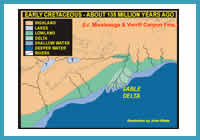
FIGURE: 7
Simplified paleogeographic reconstruction of the Scotian Basin during the Early Cretaceous (~Valanginian) time, ca. 135 mya. Deltaic sedimentation in the east was consolidated and focus in the Sable Subbasin, having ceased in the Shelburne Subbasin to the west due to depletion of its sediment sources. The Sable Subbasin's faulted basement and deeply-buried salts coupled with rapid sedimentation facilitated the creation of many syndepositional growth-fault structures and resultant over-pressure conditions. Copyright © Atlantic Geoscience Society - used with permission.
Simplified paleogeographic reconstruction of the Scotian Basin during the Early Cretaceous (~Valanginian) time, ca. 135 mya. Deltaic sedimentation in the east was consolidated and focus in the Sable Subbasin, having ceased in the Shelburne Subbasin to the west due to depletion of its sediment sources. The Sable Subbasin's faulted basement and deeply-buried salts coupled with rapid sedimentation facilitated the creation of many syndepositional growth-fault structures and resultant over-pressure conditions. Copyright © Atlantic Geoscience Society - used with permission.
Middle Jurassic and Cretaceous sediment loading of unstable shelf sediment along and to the south of the basement hinge zone initiated subsidence and development of seaward-dipping growth faults which acted as traps for sand. Sediment loading also mobilized Jurassic-age salts creating a complex slope morphology (e.g. Kidston et al., 2002; Shimeld, 2004) analogous to other basins with mobile salt substrates (e.g. Gulf of Mexico). Continuous sedimentation accentuated salt mobility, and in areas where sedimentation was high, like the Sable and possibly Shelburne deltas, salt moved both vertically and in the seaward direction forming diapirs, pillows, canopies and related features. During periods of low sea level, extant rivers incised exposed outer shelf sediments, with shelf-edge delta complexes probably forming at the edge of the continental shelf (Cummings & Arnott, 2005; 2006). Such deltas supplied turbidity currents and other mass transport deposits to the slope during the Middle Jurassic through Cretaceous, where potential reservoirs were deposited in canyons and intra-slope minibasins.
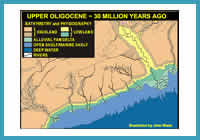
FIGURE: 8
Simplified paleogeographic reconstruction of the Scotian Basin during the Upper Oligocene (Chattian) ca. 30 mya. The figure illustrates the Chattian age sea level fall and resultant exposure and erosion on the Nova Scotia margin (Chattian unconformity). Smaller shelf margin deltas and their locations are speculative. Slightly modified after the Atlantic Geoscience Society - Copyright © AGS, used with permission.
Simplified paleogeographic reconstruction of the Scotian Basin during the Upper Oligocene (Chattian) ca. 30 mya. The figure illustrates the Chattian age sea level fall and resultant exposure and erosion on the Nova Scotia margin (Chattian unconformity). Smaller shelf margin deltas and their locations are speculative. Slightly modified after the Atlantic Geoscience Society - Copyright © AGS, used with permission.
Deltaic sedimentation ceased along much of the Scotian margin following a late Early Cretaceous major marine transgression when the shelf was blanketed by thick shales of the Naskapi Member of the Logan Canyon Formation. Transgressive shales were periodically interrupted during the influx of coarser clastics in the Aptian-Cenomanian (Cree and Marmora members of the Logan Canyon Formation; Wade and MacLean, 1990). Sand was deposited along a broad costal plain and shallow shelf, but these eventually gave way as deeper marine shales (and some limestones) of the Dawson Canyon Formation were deposited as sediment supply decreased from the lower relief hinterland. The end of the Cretaceous period in the Scotian Basin saw a rise in sea level and basin subsidence and deposition of marine marls and chalky mudstones of the Wyandot Formation. These strata were eventually buried by Tertiary marine shelf mudstones and later shelf sands and conglomerates of the Banquereau Formation (Figure 8). Throughout the Tertiary on the Scotian margin, several major unconformities related to sea level falls occurred. During Paleocene, Oligocene and Miocene times, fluvial and deep-water current processes cut into and eroded these mostly unconsolidated sediments and transported sediments out into the deeper water slope and abyssal plain. During the Quaternary Period of the last 2 million years, several hundred metres of glacial and marine sediments were deposited on the outer shelf and upper slope.